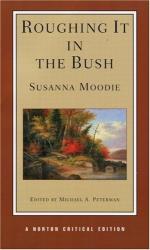There never was a people more sensible of kindness, or more grateful for any little act of benevolence exercised towards them. We met them with confidence; our dealings with them were conducted with the strictest integrity; and they became attached to our persons, and in no single instance ever destroyed the good opinion we entertained of them.
The tribes that occupy the shores of all these inland waters, back of the great lakes, belong to the Chippewa or Missasagua Indians, perhaps the least attractive of all these wild people, both with regard to their physical and mental endowments.
The men of this tribe are generally small of stature, with very coarse and repulsive features. The forehead is low and retreating, the observing faculties large, the intellectual ones scarcely developed; the ears large, and standing off from the face; the eyes looking towards the temples, keen, snake-like, and far apart; the cheek-bones prominent; the nose long and flat, the nostrils very round; the jaw-bone projecting, massy, and brutal; the mouth expressing ferocity and sullen determination; the teeth large, even, and dazzlingly white. The mouth of the female differs widely in expression from that of the male; the lips are fuller, the jaw less projecting, and the smile is simple and agreeable. The women are a merry, light-hearted set, and their constant laugh and incessant prattle form a strange contrast to the iron taciturnity of their grim lords.
Now I am upon the subject, I will recapitulate a few traits and sketches of these people, as they came under my own immediate observation.
A dry cedar-swamp, not far from the house, by the lake shore, had been their usual place of encampment for many years. The whole block of land was almost entirely covered with maple trees, and had originally been an Indian sugar-bush. Although the favourite spot had now passed into the hands of strangers, they still frequented the place, to make canoes and baskets, to fish and shoot, and occasionally to follow their old occupation.
Scarcely a week passed away without my being visited by the dark strangers; and as my husband never allowed them to eat with the servants (who viewed them with the same horror that Mrs. D—– did black Mollineux), but brought them to his own table, they soon grew friendly and communicative, and would point to every object that attracted their attention, asking a thousand questions as to its use, the material of which it was made, and if we were inclined to exchange it for their commodities?
With a large map of Canada, they were infinitely delighted. In a moment they recognised every bay and headland in Ontario, and almost screamed with delight when, following the course of the Trent with their fingers, they came to their own lake.
How eagerly each pointed out the spot to his fellows; how intently their black heads were bent down, and their dark eyes fixed upon the map. What strange, uncouth exclamations of surprise burst from their lips as they rapidly repeated the Indian names for every lake and river on this wonderful piece of paper.




